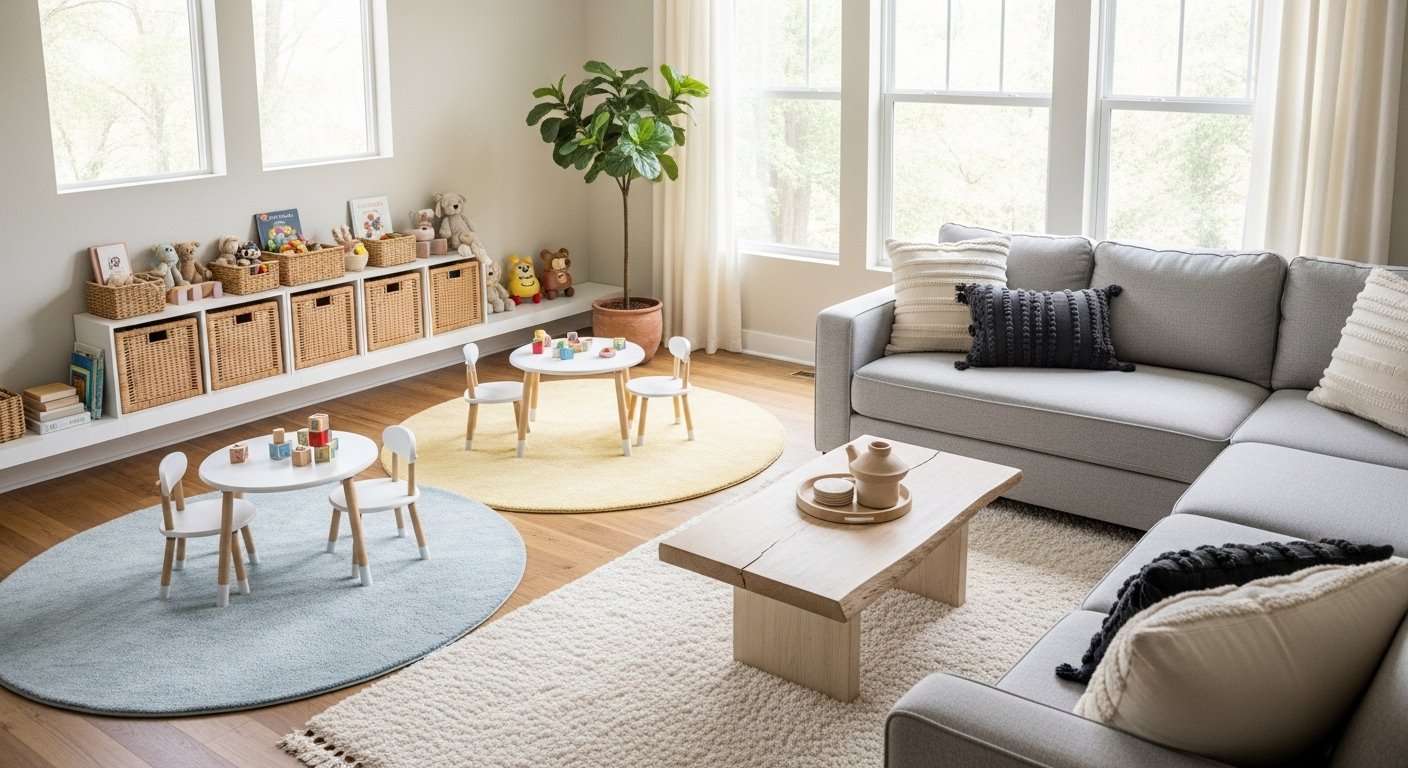INTRODUCTION
If you’ve ever tripped over toy trucks in your living room or struggled to find space for both adult relaxation and children’s play, you’re not alone. Modern families increasingly face the challenge of creating multipurpose spaces that serve everyone’s needs without sacrificing style or functionality. The solution? A thoughtfully designed playroom family room combo that brings harmony to your home.
In this comprehensive guide, you’ll discover practical strategies for combining a living room and playroom, expert-approved toy storage solutions, zoning techniques that define separate areas, and safety considerations that protect your little ones while preserving your sanity. Whether you’re working with a spacious open-plan layout or a compact apartment, these playroom family room ideas will help you create a child-friendly living space that the whole family can enjoy.
Why Combine Your Living Room and Playroom?
Creating a living room playroom combo setup offers numerous advantages for modern families. Instead of isolating children in a separate room, a shared living and play area design keeps the family connected throughout the day. Parents can supervise playtime while handling household tasks, working from home, or simply relaxing.

This approach also maximizes your home’s square footage. Rather than dedicating an entire room solely to toys that may only be used a few hours daily, you’re creating a multipurpose family room that serves multiple functions efficiently. The shared space naturally encourages children to develop social skills, learn to share common areas, and understand that homes belong to everyone.
From a practical standpoint, having a play corner in family room keeps toys from migrating throughout your entire house. When everything has a designated place within your main living area, cleanup becomes more manageable and your home stays more organized.
Understanding the Challenges of a Shared Living and Play Area
Before diving into solutions, it’s important to acknowledge the real challenges families face with this setup:
Visual clutter can overwhelm a space when colorful toys compete with your carefully chosen decor. Storage struggles emerge when you don’t have dedicated systems to contain the constant influx of toys, books, and games. Conflicting needs arise when adults want to entertain guests or watch evening television while play items dominate the visual landscape.
Safety concerns become paramount when you’re mixing adult furniture with active play areas. Noise levels can escalate quickly in shared spaces, making it difficult for parents to take work calls or enjoy quiet time.
The good news? Each of these challenges has practical solutions that we’ll explore throughout this guide.
How to Create a Play Area in the Living Room Without Clutter: Essential Planning Steps
Assess Your Space and Family Needs
Start by measuring your living room and identifying dead zones that aren’t currently serving a purpose. Corner spaces, areas beneath windows, and sections behind sofas often become natural candidates for play zones.
Consider your family’s lifestyle honestly. Do you entertain frequently? Do you need the living room for work-from-home setups during the day? How many hours daily will children actually use this play space? Your answers will guide every subsequent decision.
Define Zones Within Your Open-Plan Family Play Space
Successful living room play area integration relies heavily on zoning. Even without physical walls, you can create distinct psychological boundaries that help everyone understand where play happens versus where relaxation occurs.
Use area rugs to define territory. A colorful, washable rug instantly signals “this is the play zone” while protecting your floors and containing mess. Choose sizes that adequately accommodate your children’s activities without overwhelming the room.
Arrange furniture strategically. Position your sofa, bookshelf, or console table to create a natural barrier between adult and child zones. This doesn’t mean building walls—just establishing subtle divisions that guide traffic flow and activity separation.
Create vertical boundaries. Low open shelving units can separate spaces while maintaining sight lines for supervision. At 30-40 inches tall, these dividers define areas without blocking your view or making the room feel cramped.
Select the Right Location for Your Play Corner in Family Room
The ideal placement depends on several factors:
Near natural light: Children benefit from bright spaces, and you’ll appreciate not needing artificial lighting during daytime play. Position the play area near windows when possible.
Away from main traffic paths: Avoid placing toys in routes between doorways where they’ll constantly be disturbed or create obstacles.
Within sight lines: Even when you’re in the kitchen or working on your laptop, you should have clear visibility of the play area for safety and supervision.
Consider noise implications: If possible, locate the play zone away from walls shared with bedrooms or home offices to minimize sound transfer.
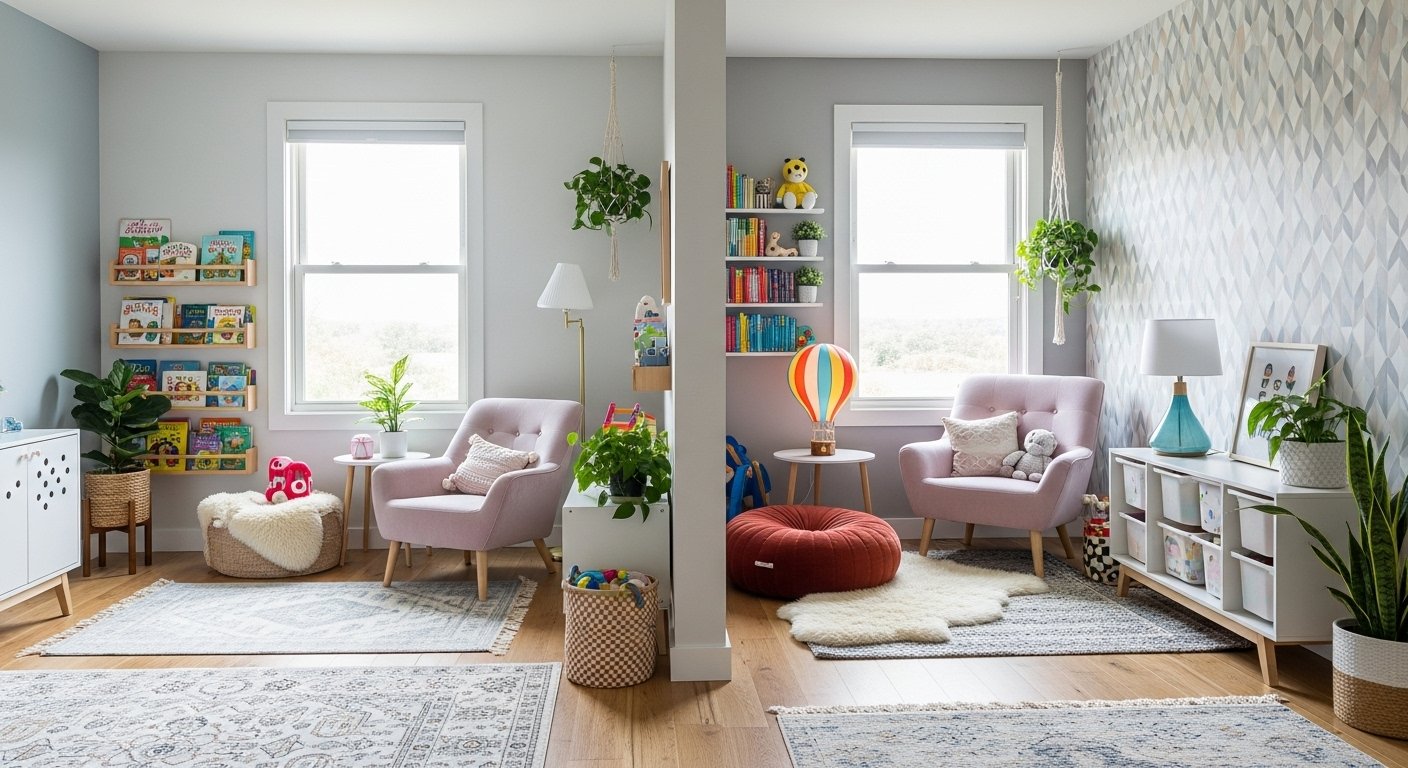
Best Toy Storage Solutions for Small Living Rooms
Storage makes or breaks a successful playroom in living room setup. Without adequate, accessible storage, toys will perpetually scatter across your space.
Multi-Functional Storage Furniture
Storage ottomans serve triple duty as seating, footrests, and hidden toy containers. Choose ottomans with removable lids that children can easily access without help.
Coffee tables with built-in storage replace traditional tables while providing concealed space for coloring books, puzzles, and other flat items.
Bench seating with lift-up compartments along walls or beneath windows creates seating areas while hiding substantial toy collections.
Open Shelving Systems
Low, accessible shelving allows children to independently retrieve and return toys, fostering responsibility and organizational skills. Choose systems with:
- Adjustable shelves that grow with your children’s changing needs
- Rounded edges for safety
- A mix of open cubbies and basket inserts for different toy types
- Neutral colors that blend with adult decor
Label shelves with pictures and words so even pre-readers know where items belong. This simple step dramatically improves cleanup success rates.
Basket and Bin Organization
Categorize toys into coordinated baskets or fabric bins:
- Building blocks in one container
- Stuffed animals in another
- Art supplies in a third
- Toy vehicles in a fourth
Choose attractive baskets in materials and colors that complement your living room aesthetic. Natural woven baskets, canvas bins, or felt containers often work beautifully in contemporary spaces.
The key is making storage intuitive enough that a tired four-year-old can still complete cleanup time successfully.
Wall-Mounted Storage Solutions
When floor space is limited, look upward:
Floating shelves display books with covers forward, turning them into decorative elements while keeping them accessible. Arrange by color for a visually pleasing rainbow effect.
Wall-mounted pegboards provide customizable storage for art supplies, dress-up items, or small toys. Choose pegboards painted in colors that coordinate with your room.
Hanging organizers with clear pockets work well for small toys, craft materials, or rotating toy collections you swap out periodically.
Furniture with Hidden Storage
Select primary furniture pieces that pull double duty:
Entertainment centers with lower cabinets conceal substantial toy volumes while housing your television above.
Sideboards and credenzas offer closed storage that maintains a clean visual line while providing ample hidden space.
Window seats with storage beneath maximize awkward spaces while creating cozy reading nooks.
Child-Friendly Living Room Ideas That Don’t Sacrifice Style
Creating a kid-friendly living room doesn’t mean surrendering to primary colors and character-themed chaos. Modern design offers sophisticated approaches to child-friendly spaces.
Furniture Selection for Living Room Play Zones
Choose durable, washable fabrics. Performance fabrics engineered for high-traffic commercial spaces stand up beautifully to juice spills and marker mishaps. Many contemporary options feel luxurious while being virtually indestructible.
Select furniture with rounded edges rather than sharp corners. This protects both running toddlers and your own shins during late-night navigation.
Invest in stain-resistant treatments. Professional fabric protection sprays provide an invisible shield against most common household mishaps.
Consider modular seating that adapts as needs change. Sectional sofas can be rearranged, and individual poufs or floor cushions provide flexible seating for both play dates and adult gatherings.
Color Schemes That Work for Everyone
You don’t need to choose between adult sophistication and child appeal:
Neutral base + colorful accents creates a timeless foundation you can easily update. Maintain neutral walls, flooring, and major furniture pieces, then introduce color through easily changeable elements like throw pillows, artwork, and toy storage baskets.
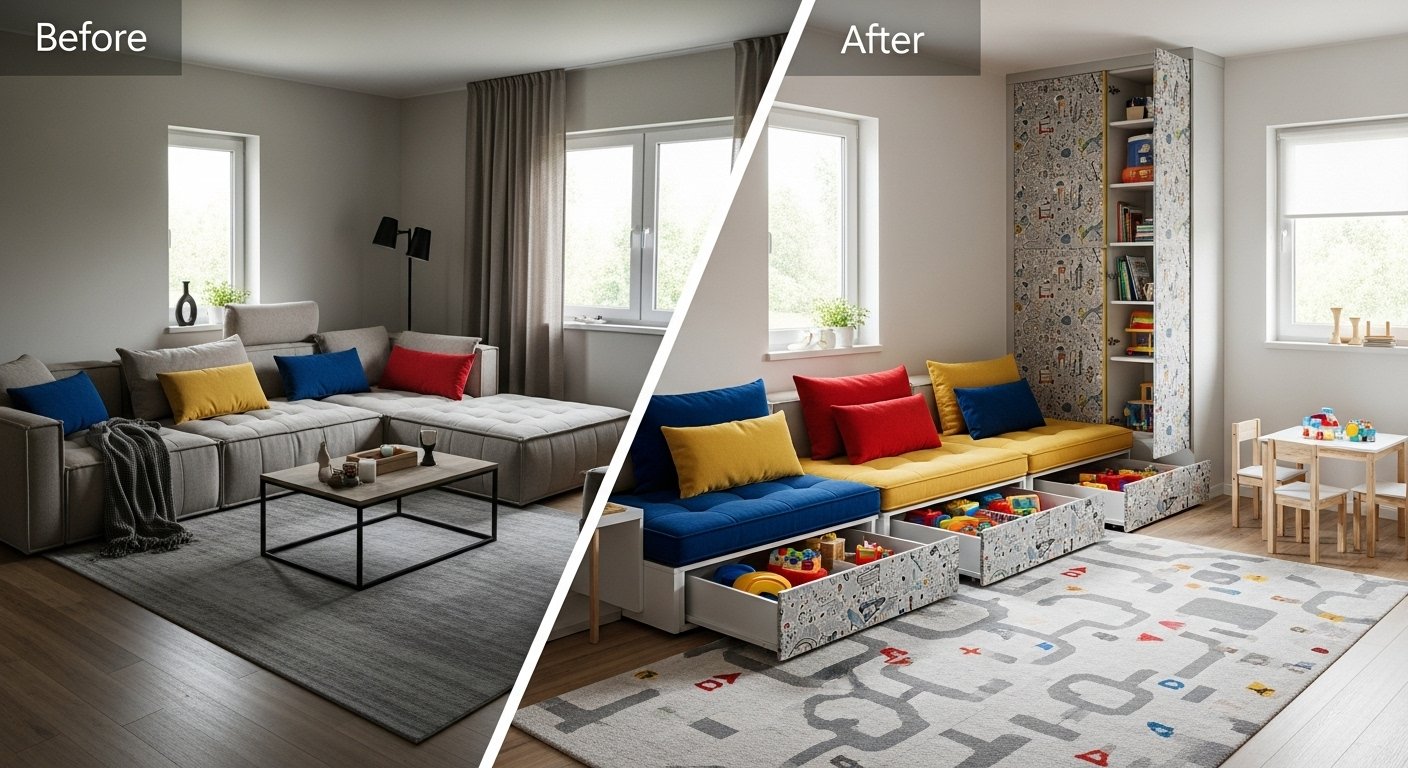
Sophisticated takes on primary colors work beautifully. Instead of bright fire-engine red, choose deeper burgundy or rust. Swap electric blue for navy or slate. Replace sunshine yellow with mustard or gold.
Nature-inspired palettes satisfy both demographics. Forest greens, warm woods, soft blues, and earthy terracottas create calm yet engaging environments.
Allow one accent wall or area where children’s artwork, colorful decals, or playful wallpaper celebrates their space without overwhelming the entire room.
Decor That Doubles as Play Equipment
Large floor cushions serve as casual seating for adults and building materials for children’s forts.
Art displays with rotating galleries showcase children’s creations with the same respect you’d give professional artwork. Use matching frames on a gallery wall or clipboards painted coordinating colors for easy rotation.
Musical instruments as decor turns functional items into sculptural elements. A beautiful guitar on a wall stand, a small keyboard on a shelf, or a collection of percussion instruments in an attractive basket becomes both art and entertainment.
Educational posters and maps in attractive frames provide learning opportunities while adding visual interest adults appreciate.
Child-Safe Playroom Design Ideas for Shared Spaces
Safety cannot be an afterthought when designing a multipurpose family room.
Securing Furniture and Preventing Tip-Overs
Every year, thousands of children are injured by furniture tip-overs. In a living room play area, this risk intensifies.
Anchor all tall furniture to walls using appropriate hardware. Don’t assume weight alone prevents tipping—climbing children create surprising leverage.
Use furniture straps on entertainment centers, bookshelves, and dressers. These inexpensive safety devices provide peace of mind and take minutes to install.
Avoid top-heavy furniture arrangements. Store heaviest items in lower drawers and shelves.
Electrical Safety in Play Zones
Cover unused outlets with outlet covers or install tamper-resistant receptacles.
Keep cords concealed behind furniture or within cord management systems. Exposed cords invite pulling and create tripping hazards.
Position electronics well out of reach when not in supervised use.
Choosing Non-Toxic Materials
Children in play areas frequently touch surfaces and occasionally taste objects they shouldn’t.
Select low-VOC or zero-VOC paints that don’t off-gas harmful chemicals.
Choose natural materials when possible—solid wood, natural fiber rugs, and organic fabrics minimize chemical exposure.
Verify toy safety certifications and avoid toys with small parts for households with children under three.
Creating Soft Landing Zones
Area rugs with quality padding underneath soften falls and provide comfortable play surfaces.
Foam floor tiles in play corners offer additional cushioning without looking obviously juvenile. Many contemporary options feature wood grain or neutral patterns.
Floor cushions and poufs scattered around play zones provide both seating and soft landing spots.
Ways to Combine Living Room and Playroom: Layout Strategies

The Corner Conversion
Dedicating one corner exclusively to play concentrates toys in a defined zone. This works particularly well in larger living rooms where you can spare 6-8 feet of corner space.
Position low shelving along two walls forming the corner, add a rug defining the boundary, and you’ve created a distinct play area that doesn’t dominate the entire room.
The Wall-to-Wall Approach
In smaller spaces, consider running low storage along one complete wall. This creates a play zone in front of that wall while leaving the majority of the room for adult living space.
Choose storage that doesn’t exceed couch height to maintain visual flow and prevent the space from feeling cramped.
The Central Island Method
For truly open-plan spaces, create a low central storage island that children can access from all sides. This becomes a natural play hub where multiple children can engage simultaneously while parents maintain sight lines from anywhere in the room.
The Behind-the-Sofa Solution
If your sofa sits away from walls, the space behind it often goes unused. A long, low console table or set of cube storage behind the sofa can house toys while keeping them out of the main living area sight line.
Convertible Spaces for Evening Transformation
Some families prefer play areas that completely disappear for adult evening hours:
Storage pieces on casters roll away when not needed.
Folding screens quickly conceal play zones when guests arrive.
Ottoman storage swallows toys in seconds before bedtime, transforming the space back to adult territory.
Real-Life Examples: Shared Living and Play Area Success Stories
The Urban Apartment Solution
Sarah, a mother of two in a 900-square-foot Brooklyn apartment, created a stunning living room playroom combo setup by dedicating the space beneath her mounted television to a built-in storage system. Custom cabinets in matching white paint blend seamlessly with her walls, concealing an impressive toy collection. Above the cabinets, floating shelves display picture books organized by color, creating an artistic installation that adults admire. A washable rug in front of the storage defines the play zone without visual clash. “Guests consistently comment on how organized and grown-up our space feels, even though we have two kids under five,” Sarah reports.
The Open-Concept Transformation
The Martinez family converted their 20×15 open-concept family room by positioning their sectional sofa to create a natural division. Behind the sofa, they installed a low bookshelf perpendicular to the wall, forming a defined play corner without blocking light or views. Woven baskets on the shelves contain toys categorized by type, while art supplies live in a rolling cart that tucks into a closet after use. The neutral gray sectional anchors the adult space while coordinating with the colorful rug in the children’s zone. “This layout lets me prepare dinner while watching the kids play, and nothing feels cramped,” explains Maria Martinez.
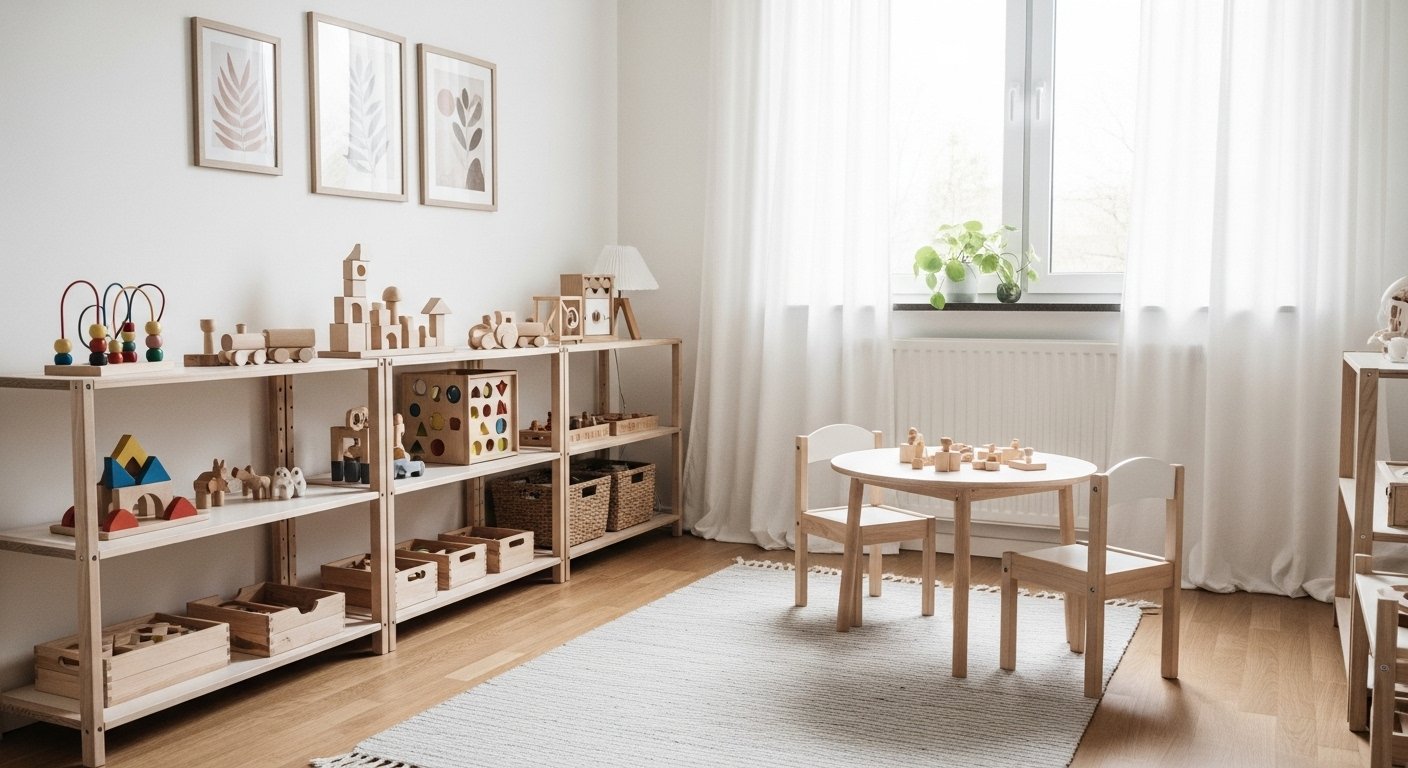
The Small-Space Win
In their 650-square-foot studio apartment, the Chen family employs vertical storage brilliantly. Wall-mounted pegboards hold art supplies and small toys, while a storage ottoman serves as both seating and toy container. Their coffee table lifts to reveal additional storage for puzzles and games. At night, toys disappear completely, transforming the space for adult use. “We thought we’d need a bigger place, but smart storage made our studio work beautifully for our family of three,” notes parent David Chen.
Pros and Cons of Living Room Playroom Combo Setups
Advantages
Enhanced family connection: Parents and children spend more quality time together when sharing spaces rather than being separated into different rooms.
Improved supervision: You can monitor children’s activities without hovering, naturally keeping them safe while you handle other tasks.
Efficient space utilization: Multipurpose rooms make sense economically and practically, especially for families without extra rooms to dedicate solely to play.
Easier cleanup management: When toys have designated living room homes rather than being scattered across multiple rooms, tidying becomes more straightforward.
Natural integration: Children learn to be part of family life rather than being isolated, developing social awareness and sharing skills.
Cost-effective: You’re maximizing rooms you already pay to heat, cool, and maintain rather than maintaining separate spaces with separate furniture, storage, and decor.
Challenges
Visual clutter concerns: Even with excellent storage, a play area in a primary living space requires constant maintenance to avoid looking chaotic.
Competing aesthetic preferences: Balancing adult design sensibilities with child-friendly functionality demands compromise and creativity.
Noise considerations: Active play generates noise that can interfere with adult activities like work calls, television viewing, or conversation.
Limited privacy: Adults lose a child-free zone for entertaining guests or relaxing without navigating toys.
Constant organization required: Unlike a dedicated playroom where doors can close on mess, living room play areas demand daily tidying to remain functional.
Safety vigilance: Mixing adult furniture with active play requires ongoing attention to potential hazards.
Solutions to Common Challenges
Most challenges have workable solutions:
For visual clutter, implement the “one toy out, one toy away” rule and schedule quick ten-minute tidy sessions three times daily.
For aesthetic conflicts, choose storage and toys in colors that coordinate with your existing decor palette.
For noise issues, establish quiet time rules during work calls or adult conversation hours, and use rugs and fabric elements to absorb sound.
For privacy needs, create signal systems (a certain lamp turned on means “adult quiet time”) or establish evening routines where play spaces transform for adult use.
Frequently Asked Questions About Playroom Family Room Ideas
How do you combine a playroom and a family room?
Combine these spaces successfully by zoning specific areas for play using rugs, furniture placement, and dedicated storage. Choose multipurpose furniture that serves both adult and child needs, implement storage solutions that blend with your decor, and establish clear boundaries about where play happens versus where adult activities occur. The key is creating distinct psychological spaces within one physical room.
What is the best way to organize toys in the living room?
The most effective approach categorizes toys by type into labeled bins and baskets stored on accessible low shelving. Rotate toys seasonally to prevent overwhelming the space, keeping only age-appropriate, frequently used items in the living room while storing others elsewhere. Implement daily cleanup routines and use vertical storage solutions like wall-mounted shelves to maximize floor space. Make storage intuitive enough that children can independently complete cleanup.
How do you create a play area in a small living room?
In small spaces, prioritize vertical storage with wall-mounted shelves and pegboards. Choose furniture with hidden storage like ottomans and coffee tables with lift-tops. Define a specific corner or wall area as the play zone using a small area rug. Keep toy collections curated to only favorites and seasonally appropriate items. Consider convertible solutions that completely hide toys when not in use, transforming the space for adult activities.
Should a playroom be in the living room?
This decision depends on your family’s specific needs, home layout, and lifestyle. A living room playroom works beautifully for families who value connection and supervision, have limited square footage, or want to maximize home efficiency. However, families who frequently entertain adults, need quiet work-from-home spaces, or have rooms to spare might prefer separate dedicated playrooms. Neither approach is inherently superior—choose what serves your unique situation.
How do you zone a living room play area?
Zone effectively using these techniques: Position area rugs to define the play territory visually; arrange furniture like sofas and bookcases to create natural barriers; install low shelving as subtle dividers that maintain sight lines; use consistent storage systems within the play zone; choose different lighting for play versus relaxation areas; and maintain consistent visual themes within each zone while ensuring overall room cohesion.
What are the best toy storage solutions for small living rooms?
Prioritize multifunctional storage furniture including ottomans with hidden compartments, coffee tables with shelves or lift-tops, and benches with storage beneath seats. Use wall-mounted floating shelves and pegboards to maximize vertical space. Choose stackable bins and baskets that fit standard shelving units. Consider furniture on casters that can roll away when not needed. Select pieces that blend with your existing decor to maintain visual harmony.
How can I make my living room safe for children?
Anchor all tall furniture to walls using appropriate safety straps; cover electrical outlets; secure blind cords; choose furniture with rounded rather than sharp edges; select shatter-resistant coffee tables or add edge guards to existing pieces; remove or secure heavy decorative items that could fall; use cord management systems to eliminate tripping hazards; and install baby gates if needed to prevent access to stairs or dangerous areas.
What colors work best for a living room playroom combo?
Choose a neutral foundation of whites, grays, or beiges for walls and large furniture pieces, then introduce color through easily changeable elements like throw pillows, artwork, and storage baskets. This allows you to adapt color schemes as children’s preferences evolve without repainting or replacing major investments. Nature-inspired palettes of greens, blues, and earthy tones appeal to all ages while creating calm environments conducive to both play and relaxation.
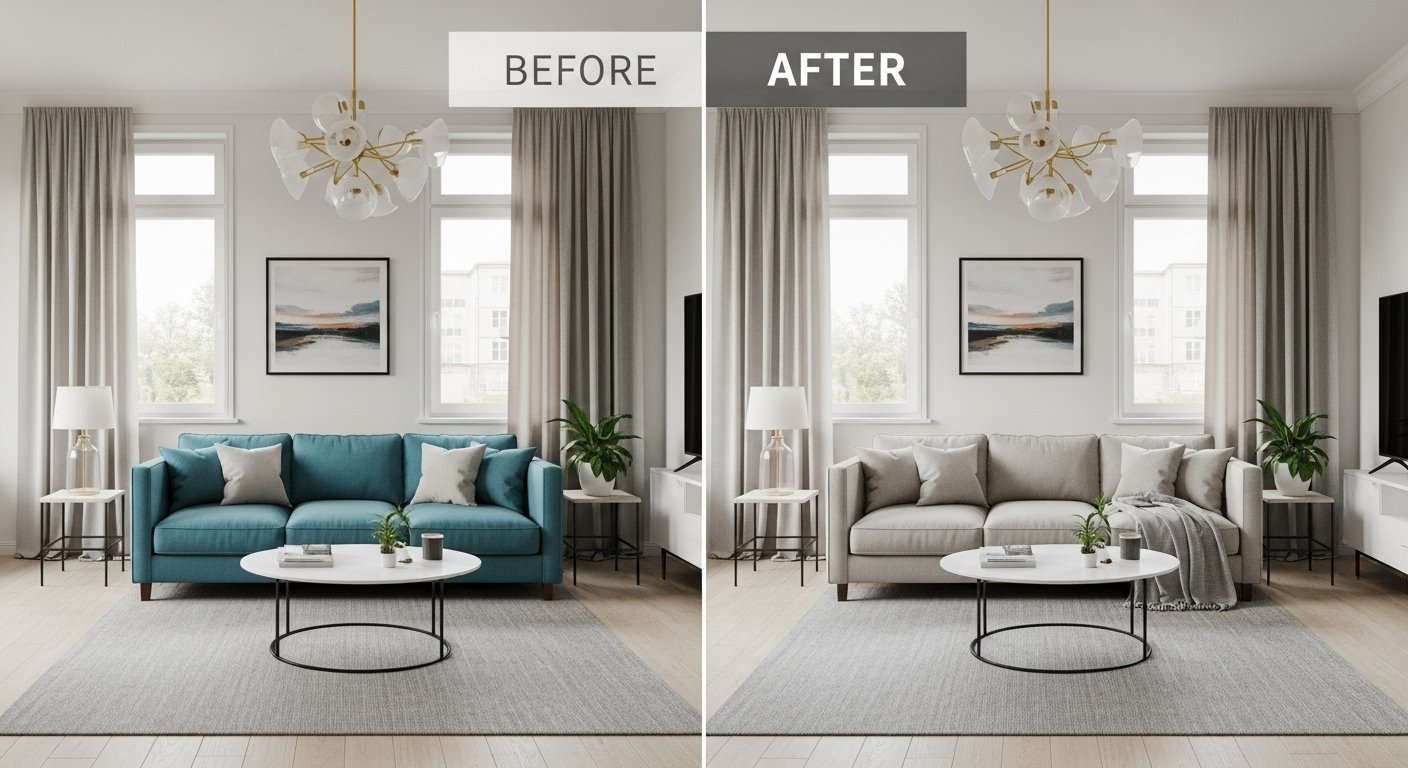
Conclusion: Creating Your Perfect Shared Living and Play Space
Designing successful playroom family room ideas requires balancing competing needs—adult aesthetics with child functionality, supervision with privacy, and organization with accessibility. The most effective shared living and play area designs embrace flexibility, implement smart storage solutions, and establish clear zones within open spaces.
Remember that perfect doesn’t exist in family homes with young children. Some visual reminders of childhood will always be present, and that’s not just acceptable—it’s beautiful evidence of a home truly lived in and loved. The goal isn’t magazine-perfect spaces but rather functional, safe, and harmonious environments where everyone thrives.
Start with small changes: add one storage ottoman, install floating shelves, or define a play corner with a new rug. As you discover what works for your specific family, you can expand and refine your approach. The best living room playroom combo setup is one that reduces daily stress, keeps your family connected, and evolves as your children grow.
Ready to transform your living room into a space that works for your whole family? Start by assessing one area in your living room that could serve double duty, then implement one storage solution this week. Share your favorite playroom family room ideas in the comments below—your experience might inspire another family finding their way!
For more inspiration and downloadable checklists on organizing family spaces, explore our related guides on toy rotation systems, child-safe design principles, and small-space storage hacks. Your dream shared living space is closer than you think.



